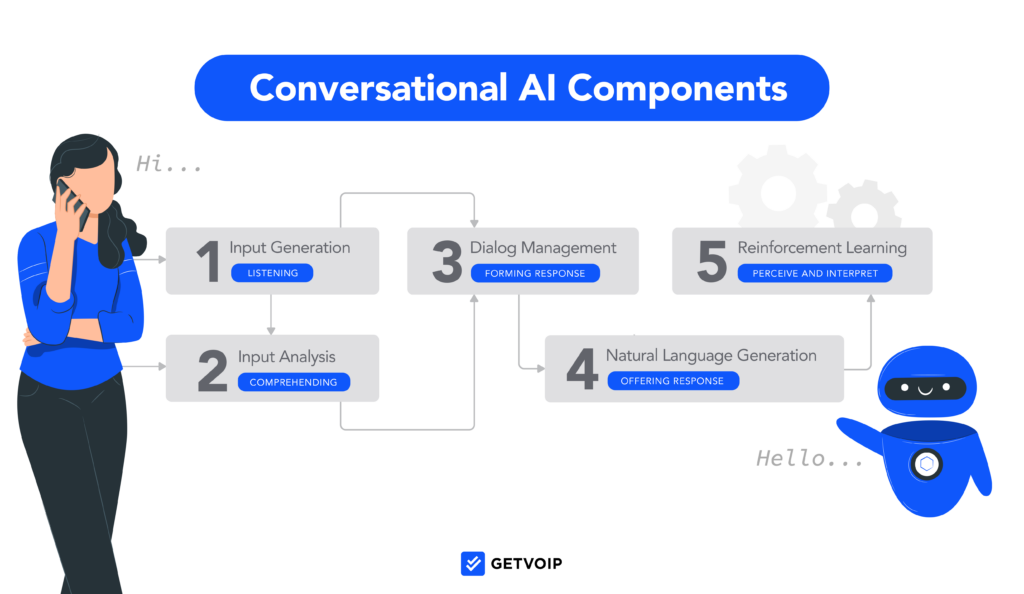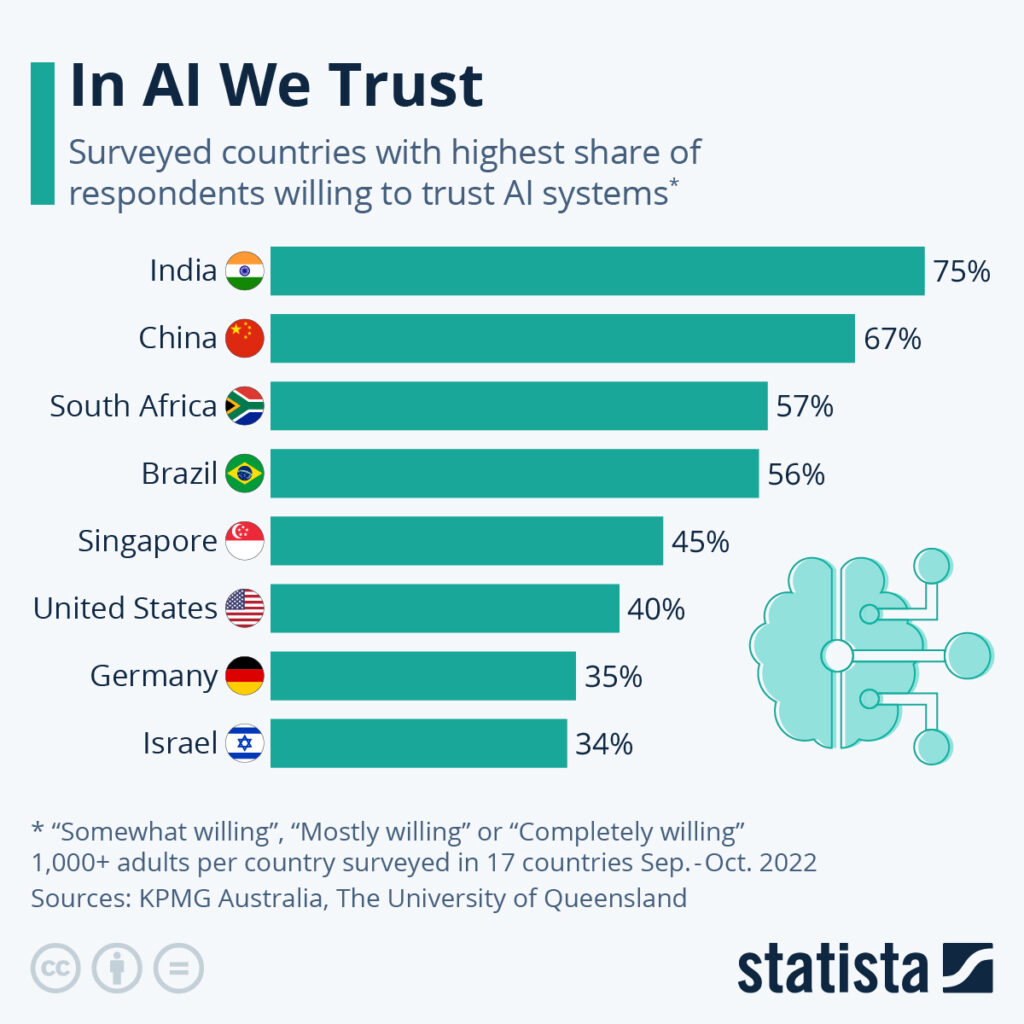Conversational IVR: What Is It & How It Differs From Traditional IVR

Salesforce recently discovered that 53% of customers believe generative AI helps companies better serve them. One way it can do so is through conversational IVR.
You’ve likely been on the phone and interacted with an IVR menu by either pressing buttons or giving short, spoken prompts. You may not, however, have come across a conversational IVR, a tool that you can speak naturally to.
Just how does it work? Read on to find out.
Key Takeaways:
- With traditional IVR, users navigate prompts and menu trees to receive information or reach an agent who can help them.
- Some systems use Dual-Tone Multi-Frequency (DTMF) technology which sees users press buttons to select options, while other IVR systems use AI for speech recognition.
- When set up and customized effectively, IVR self-service first call resolution can be as high as 74%.
- Conversational IVR uses AI technology (particularly natural language processing) to interpret caller statements and generate human-like responses.
- There are pros and cons for traditional IVR vs conversational IVR, and many businesses don’t require the level of complexity in their IVR system that conversational IVR introduces.
What Is Conversational IVR?
Conversational IVR is a type of interactive voice response system. It uses natural language processing (NLP) and speech recognition technology to have human-like interactions with callers.
A conversation with Siri or Alexa is an everyday—if simplified—example of the same type of interaction as you may have with conversational IVR software. The goal is to help users arrive at a solution or connect them to someone who can find a solution.
How Does Conversational IVR Work?
The technology powering conversational IVR is complex. However, the basic flow of how a conversation takes place breaks down into five steps:

- Caller inputs – NLP identifies the user’s language and translates the basic meaning behind the customer’s statement.
- User intent analysis – Natural language understanding (NLU) ascertains the true meaning of a statement. It takes into account not only what a customer is saying but how they’re saying it.
- Response management – Data from NLP and NLU both feed into the natural language generation (NLG) component. NLG is the technology which generates a response with audible, human-like speech. A calculated response accounts for personal details or prior call history when appropriate.
- Humanize the interaction – All three conversation AI components work together, producing a human-like response.
- Learning and reinforcement – The next caller’s response will go through the same process. The AI analyzes language and meaning. It now ascertains the successes or failures of the previous interaction and “learns” for future conversations.
What’s the Difference Between Traditional and Conversational IVR?
Traditional and conversational IVR aim to achieve the same goals. The way they accomplish these goals differs, and the results vary depending on use cases.
Aspect
Traditional IVR
Conversational IVR
Interaction Style
Menu-driven, structured with sub-menus
Natural language, conversation-like interaction
User Experience
Simple, familiar but sometimes limited
More intuitive and engaging
Input Methods
Optimizes call management.
Optimizes customer experience.
Flexibility
Flexibility with call flows and sub-menus
Can ignore menus, handle a range of requests, and engage in dialog
IVR Speech Recognition
Basic IVR voice recognition of commands such as “yes” or “billing”
Natural language IVR that allows for complete sentence comprehension
Response Generation
Pre-recorded prompts and fixed responses
Dynamic responses tailored to user input
Support Hours
24/7 self-service
24/7 self-service with human-like interactions
Topic Complexity
Handles low to mid-level issues depending on call flow design
Well-trained AI can handle simple and more complex customer calls
Automation Level
Some tools require complex programming, others use visual call flows for no-code automation
No-code automation
Personalization
Personalization options with CRM integrations that remember caller details
Can personalize interactions based on user data
Customer Satisfaction
Lower call wait times with caller-based routing, improves CSAT when optimized
Increase customer satisfaction due to human-like interactions
Example of Customer Interactions: Conversational vs Traditional IVR
Both conversational and traditional IVR gather customer information and find a solution. Each one offers a different customer experience.
Let’s check out an example to illustrate how each IVR type handles a query:
A customer wakes up in the morning before an early flight. They decide to dial the airline to confirm the status of their flight before they get going.
Traditional IVR
- IVR: Thank you for calling our airline. Please press 1 for ticketing, 2 to check the status of your flight…
- Customer: (Presses the corresponding button to “check the status of your flight”)
- IVR: “Please state or enter your flight number followed by the pound sign. Then, enter the departure day of your flight followed by the departure month.”
- Customer: “Flight AB1234”. (Presses the pound sign.) “6th of March”
- IVR: “Flight AB1234 departing on March 6th is scheduled to depart on time at 1230.”
Conversational IVR
- IVR: “Hello, thank you for calling our airline. How can I help you today?”
- Customer: “Can you help me check the status of my flight?”
- IVR: “Of course, I can assist you with that. Can you provide me with your flight number and departure date?”
- Customer: “Yes. My flight number is AB1234 and it leaves today, March 6th.”
- IVR: “Thank you. Your flight AB1234 departs today, March 6th, and is scheduled to depart on time at 1230.”
In each interaction, the customer was able to achieve an answer to their question without the help of an agent. Which one is best for you comes down to a combination of IVR pricing and your individual business needs.
With traditional IVR, the caller had to wait through a list of menu options before responding. The conversational IVR and AI allowed the users to start finding a solution just a bit quicker.
The customer was able to speak in both interactions, however, with conversational IVR, they were able to speak in full sentences. Otherwise, the interactions were very similar and equally satisfactory.
Conversational IVR Benefits and Drawbacks
Conversational IVR depends on AI and machine learning to deliver customer service. While this technology is powerful and robust, it does introduce challenges.
When it comes to choosing an IVR solution for your business, you will need to weigh the pros and cons of customer service automation.
Conversational IVR Benefits
- Automate more customer interactions – When conversational AI and IVR work together, they can handle a wider range of caller issues without agent input than either traditional IVR or phone support without any IVR. You’ll be better equipped to satisfy the 35% of customers who prefer self-service for solving problems.
- Handle more calls at once – It stands to reason that fewer menus to navigate means lower average handle times. It’s quicker for a caller to listen to one message and then explain their issue, than to wait through one (or more) full menus of options. It also means less chance of callers hitting that zero button and demanding to talk with a live agent. Conversational IVR deflects simpler calls, meaning your agents have greater availability for more complex calls or those callers who prefer human interaction.
- Shorten caller wait times – Callers can speak directly to the IVR which directs them to the right place. Your customers save time listening to prompts and navigating lengthy IVR menus. Keeping average handle time down can be a battle of attrition—every little bit helps.
- Cost savings – Conversational IVR requires an upfront investment. However, it can pay off. More self-service options, lower wait times, and faster call resolutions mean your agents handle more in less time. You can optimize your agent rotas around demand and trim the fat of labor costs.
Conversational IVR Drawbacks
- Problems with underlying AI – Even the best conversational IVR isn’t 100% trustworthy. A quick interaction with generative AI tools demonstrates the caveats attached to relying on artificial intelligence. AI isn’t infallible, it still makes errors. A recent report, for instance, found that ChatGPT sorted resumes with racial bias. Every AI tool still requires the oversight of a human to ensure you’re delivering a positive customer experience every time.
- Issues when AI doesn’t recognize callers’ speech – NLP is highly evolved compared to where it came from. It gets better every day, but what about callers with unique speech patterns or impediments? Any inability to understand a caller lowers your inclusivity and accessibility for customers. Such incidents can also become a PR nightmare.
- Lacks the human touch – Conversational IVRs may be good at sounding human, but it’s not the same as talking a problem through with somebody. Many customers are more familiar and comfortable with the traditional IVR experience, which more often than not ends with them getting routed to a real person. One study, too, found that 78% of customers who used automated service channels ended up needing to connect with a human anyway.
- Some callers may not trust AI answers – While AI has traveled far, it still has a long way to go to gain total consumer trust. Forbes reports that 76% of customers are concerned with AI giving them misinformation. More alarmingly, Statista reported that only 40% of Americans are willing to trust AI systems.

Conversational IVR Is Just One Option to Boost CX
Implementing conversational IVR with NLP and machine learning lets callers partake in human-like interactions that hopefully guide them to a solution.
However, many businesses don’t require that level of complexity in their IVR system. They want something familiar with capabilities and flexibility to help them improve customer experiences.
CloudTalk’s AI-powered business calling solution features IVR functionality that fits the bill. It uses AI and automation to level up the customer experience, without relying on, as yet not 100% trustworthy, conversational and generative AI.
Our visual Call Flow Designer empowers you to build excellent customer journeys. No coding is required to manage and alter IVR interactions and custom call routing and workflow automation tools save you up to three minutes per call.
You can harness the power of AI with automatic call transcriptions and call summaries. Built-in analytics, meanwhile, give your team access to call quality and agent performance metrics in real time.
Schedule a call with our team to learn what CloudTalk can do for your business.
Conversational IVR FAQs
What Are Some Different Types of IVR?
There are several types of IVR systems. Many solutions fit into several categories. Here are some common IVR types:
Touch-tone IVR – The traditional, “press X” system. These systems use pre-recorded messages and complex menu trees to route calls.
Speech recognition IVR – Capable of understanding a few words or short phrases. They work similarly to touch-tone systems but allow for some superior streamlining.
Conversational IVR – Uses NLP to prompt, understand, and produce human-like responses.
AI-powered IVR – Presents flexible call flows for IVR menus and uses AI for speech recognition and to streamline workflows.
Intelligent IVR – A modern IVR that integrates with other business tools like a CRM for centralized data and analytics.
Is Conversational IVR the Same as an IVA?
It’s easy to get confused when it comes to IVR vs IVA. An IVA is an intelligent virtual assistant. It works in a contact center setting as an intelligent chatbot. IVAs use NLP to gather context and generate dynamic, human-like responses to customer queries.
Conversational IVR uses similar technologies including NLP to provide callers with human-like interactions. You can use conversational IVR for call routing or as a self-service option for inbound contact centers.
What’s the Difference Between Conversational IVR and a Chatbot?
There are several differences between conversational IVR and a chatbot. Firstly, conversational IVR runs off AI components like NLU and NLP. While there are AI-powered chatbots, basic bots run off rigid scripts and templates.
Secondly, conversational AI works to recognize speech and generates spoken responses. A chatbot works in text-based channels such as live chat or SMS messaging.
Does Traditional IVR Use AI?
Legacy IVRs are on-premises systems that don’t use AI. However, plenty of modern business phone solutions offer AI features with traditional IVR menus. CloudTalk IVR, visual call flows, and speech recognition all streamline inbound call handling.
What is the difference between inbound and outbound IVR?
Inbound IVR handles incoming calls, guiding callers to the correct department or service, while outbound IVR initiates automated calls to customers for reminders, notifications, or surveys. Learn more about the difference between inbound vs. outbound IVR to choose the best approach for your business needs.















